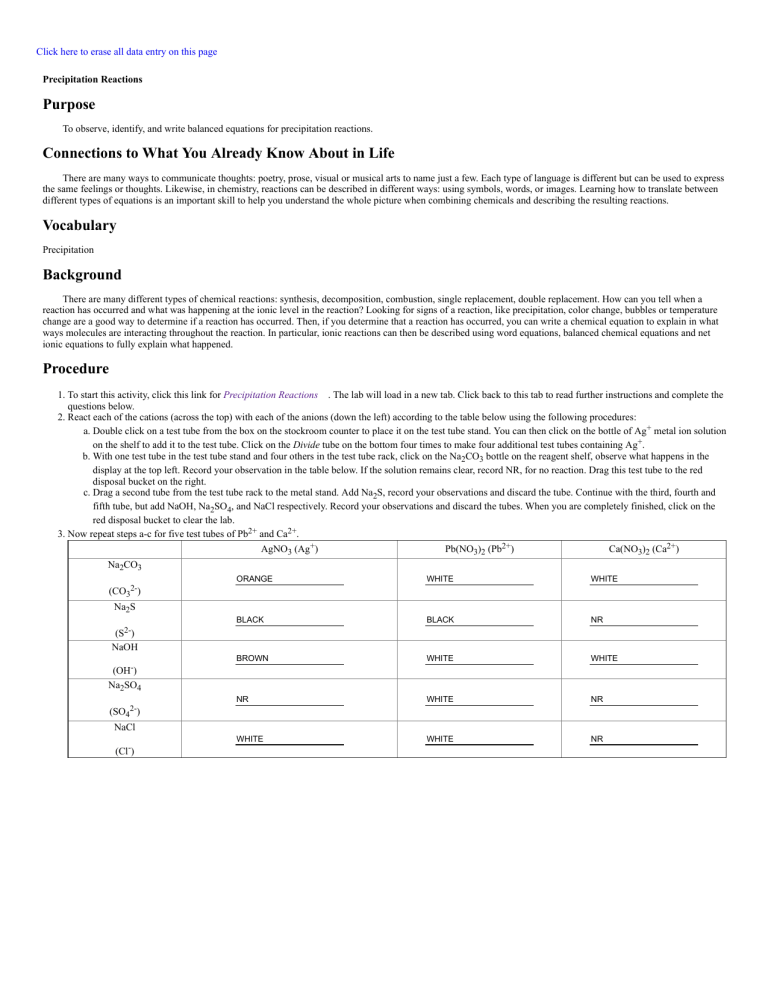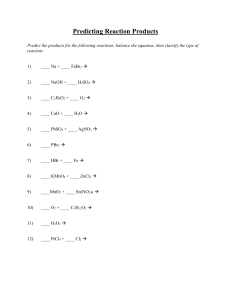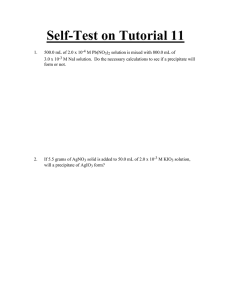
Click here to erase all data entry on this page Precipitation Reactions Purpose To observe, identify, and write balanced equations for precipitation reactions. Connections to What You Already Know About in Life There are many ways to communicate thoughts: poetry, prose, visual or musical arts to name just a few. Each type of language is different but can be used to express the same feelings or thoughts. Likewise, in chemistry, reactions can be described in different ways: using symbols, words, or images. Learning how to translate between different types of equations is an important skill to help you understand the whole picture when combining chemicals and describing the resulting reactions. Vocabulary Precipitation Background There are many different types of chemical reactions: synthesis, decomposition, combustion, single replacement, double replacement. How can you tell when a reaction has occurred and what was happening at the ionic level in the reaction? Looking for signs of a reaction, like precipitation, color change, bubbles or temperature change are a good way to determine if a reaction has occurred. Then, if you determine that a reaction has occurred, you can write a chemical equation to explain in what ways molecules are interacting throughout the reaction. In particular, ionic reactions can then be described using word equations, balanced chemical equations and net ionic equations to fully explain what happened. Procedure 1. To start this activity, click this link for Precipitation Reactions . The lab will load in a new tab. Click back to this tab to read further instructions and complete the questions below. 2. React each of the cations (across the top) with each of the anions (down the left) according to the table below using the following procedures: a. Double click on a test tube from the box on the stockroom counter to place it on the test tube stand. You can then click on the bottle of Ag+ metal ion solution on the shelf to add it to the test tube. Click on the Divide tube on the bottom four times to make four additional test tubes containing Ag+. b. With one test tube in the test tube stand and four others in the test tube rack, click on the Na2CO3 bottle on the reagent shelf, observe what happens in the display at the top left. Record your observation in the table below. If the solution remains clear, record NR, for no reaction. Drag this test tube to the red disposal bucket on the right. c. Drag a second tube from the test tube rack to the metal stand. Add Na2S, record your observations and discard the tube. Continue with the third, fourth and fifth tube, but add NaOH, Na2SO4, and NaCl respectively. Record your observations and discard the tubes. When you are completely finished, click on the red disposal bucket to clear the lab. 3. Now repeat steps a-c for five test tubes of Pb2+ and Ca2+. AgNO3 (Ag+) Pb(NO3)2 (Pb2+) Ca(NO3)2 (Ca2+) Na2CO3 (CO32-) ORANGE WHITE WHITE BLACK BLACK NR BROWN WHITE WHITE NR WHITE NR WHITE WHITE NR Na2S (S2-) NaOH (OH-) Na2SO4 (SO42-) NaCl (Cl-) Questions 1. Translate the following word equations into balanced chemical equations and explain how the equations represent what you observed. a. Sodium carbonate reacts with silver nitrate to produce sodium nitrate and solid silver carbonate. Edit Insert Formats Na2CO3 + AgNO3 ---> NaNO3 + Ag2CO3 P b. Sodium sulfide reacts with lead (II) nitrate to produce sodium nitrate and solid lead (II) sulfide. Edit Insert Formats Pb(NO3)2 + Na2S ----> PbS + 2NaNO3 P 2. Write a word equation to represent what happens when Ca(NO3)2 reacts with NaOH. Ca(NO3)2 + NaOH -----> Ca9OH)2 + NaNO3 3. What happens when AgNO3 combines with Na2SO4? What other reactions gave similar results? Is it necessary to write an equation when no reaction occurs? Explain. no it is not necessary to write an equation for when there is no reaction, because when there is no reaction between the reactants, then no product or compound substance occurs from the reaction. 4. Write balanced equations for all precipitation reactions you observed. Edit Insert Formats AgNo3 + Na2CO3 -> NaNO3 + Ag2CO3 AgNO3 + Na2S = Ag2S + NaNO3 AgNO3 + NaOH = NaNO3 + Ag2O + H2O 2Ag + 2OH = Ag2O + H2O Pb(NO3)2 + Na2CO3 = PbCO3 + NaNO3 Na2S + Pb(NO3)2 = NaNO3 + PbS Na2SO4 + Pb(NO3)2 = NaNO3 + PbSO4 Pb(NO3)2 + NaCl = PbCl2 + NaNO3 Na2CO3 + Ca(NO3)2 = NaNO3 + CaCO3 Ca2 + CO3 = CaCO3 Ca(NO3)2 + NaOH = Ca(OH)2 + NaNO3 P 5. Write balanced net ionic equations for all precipitation reactions you observed. Edit Insert Formats 2Ag + CO3 = Ag2CO3 2Ag + S2 = Ag2S AgNO3 + NaOH = NaNO3 + Ag2O + H2O 2Ag + 2OH = Ag2O + H2O Ag + Cl = AgCl Pb2 + SO4 = PbSO4 Pb2 + 2Cl = PbCl2 Ca2 + CO3 = CaCO3 Ca2 + 2OH = Ca(OH)2 P

